Sep 12, 2017 | Science and Art, Systems Analysis
By Gerid Hager, IIASA Ecosystems Services and Management Program
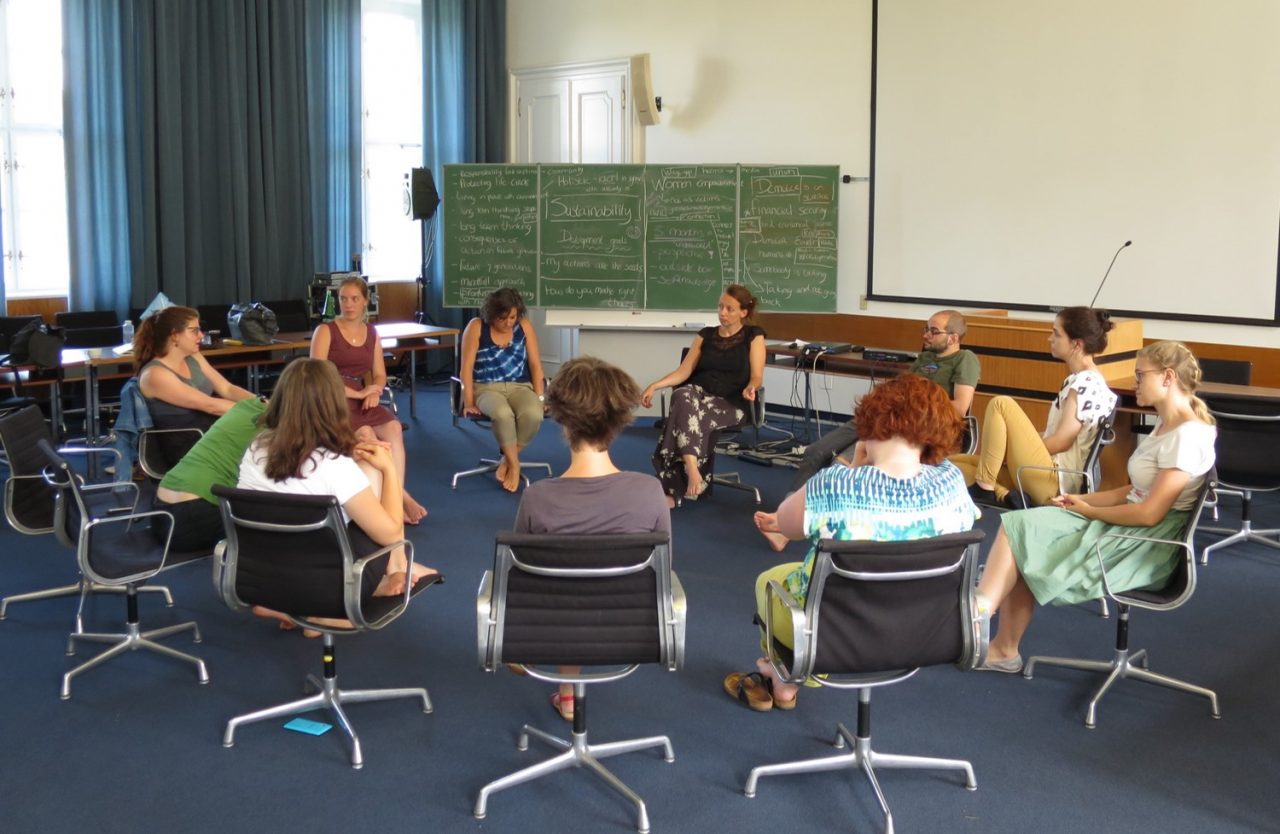
©Gerid Hager | IIASA
In July, Miranda Lakerveld, a music drama artist and founder of the World Opera Lab, visited IIASA to run two storytelling workshops with young actors in civil society and youth policy, as well as with YSSP students and IIASA staff. Miranda first came to IIASA in September 2016 as part of the Citizen Artist Incubator.
After the workshops in July, Miranda and I sat down for a chat.
Gerid: Miranda, in the workshop you shared how you approach storytelling in your artistic practice. You said: “I’m looking for moments that feel true, I pick them up and weave them together into new stories.” Then, a participant exclaimed: “Stories are not true!” It seems a contradiction, but possibly this is the very nature of stories. They might not be true, giving accurate accounts of past events, but they carry truths in them, which we so often can’t capture otherwise. You’ve been working with myths for a long time: What value do you see in them today, as we’re trying to navigate between “alternative facts” and often incomprehensible scientific writing?
Miranda: Yes, this was a short reflection on the methodology I have developed and applied in many different contexts over the last eight years. It uses comparative mythology as a starting point. The aim of the method is to create a meaningful creative exchange that can involve people from all walks of life. Myths are examined from the perspectives of different cultures, and through this intercultural lens, we find symbols and archetypes that resonate as ‘true’ across cultures.
The ‘post-truth’ era made us extra aware of the divides between communities and I believe such an embodied practice of mythology can be an inspiring place for people to meet. I think the renunciation of facts and scientific insight is a symptom of people feeling left out and angry. Using myths and stories can be one way to bring people together and find common truths.
This workshop was part of the Systems Thinking for Transformation project and we wanted to search for “systems stories” in ancient narratives. We arrived at a very personal story of endurance and adaptation, pondered the power of great nature and cyclical behavior on a very large scale, and discussed economic justice and its relation to sustainable development. How does one story from Greek mythology – the Hymn to Demeter – lead to such diverse considerations?
The development of myths and folk stories has very specific characteristics, which I like to compare to ecosystems. Symbols and characters create organisms in constant interaction with their environments. Through time, myths change, in fertile circumstances the stories flourish, and layers of meaning are added.
Participants relate the Greek myth to myths from their own cultural backgrounds, and then to their personal histories. Interestingly, in the encounter between the myth and a group, some deeply felt preoccupations spring up from under the surface. I am still not sure how this happens. It probably has to do with a combination of embodiment of the characters, the richness of the archetypes, and the mise en scène, which represents the people inside the larger system.

Majnun & Leyla- World Opera Lab 2016- photo by Fouad Lakbir
One integral part of systems thinking is to be able to consider and explore multiple perspectives on a problem or situation. How does the embodiment exercise come in to this?
Slipping into different characters from the story is an essential part of the process. It unlocks the creative imagination and is related to action in society. The Greek root-word for drama is “dran”, which means “to act”. Through embodiment we can take the position of another character or force in the system. The performing arts make this possible: we can take on different roles, understand new parts, and at the same time experience the whole system from a new perspective.
There are other examples of how art and science meet through storytelling. A researcher at Berkeley University teamed up with story artists from PIXAR to help researchers create better stories about their research. What interests you in working with scientists and what is the role of storytelling?
I think the collaboration between art and science could go far beyond creating stories about research. We see very different approaches of creating and transmitting knowledge. So we have to deal with this tension but an inclusive society also means we should value these differences. The academic world has created an intricate system of validating knowledge leading to very specialized fields of research. Artists work on larger ideas, but the output cannot necessarily be validated. We are trying to grasp truths about the same river, but we work from opposite river banks. I think we can build bridges and increase our ability for insight and action by telling stories together.
This article gives the views of the author, and not the position of the Nexus blog, nor of the International Institute for Applied Systems Analysis.
Apr 28, 2017 | Alumni, Systems Analysis, Young Scientists
University of Tokyo researcher Ali Kharrazi credits the 2012 IIASA Young Scientists Summer Program (YSSP) with strengthening his passion, and giving him the research skills, to make a positive impact on humanity and sustainable development. He continues to collaborate with the institute as a guest researcher.
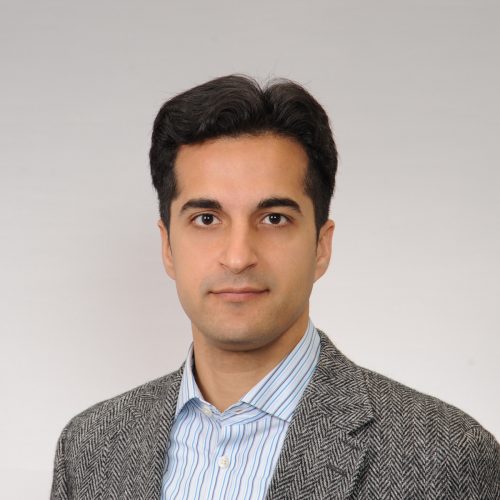
Ali Kharrazi
What is your research focus?
I’m currently examining both theoretical and empirical dimensions related to resilience and the wider application of sustainability indices and metrics. Towards this end, I have lately completed a literature review of empirical approaches to the concept of resilience, examined the resilience of global trade growth, and examined the resilience of water services within a river basin network.
My future project includes the examination of the application of modularity for resilience and its impact on other system characteristics of resilience, such as redundancy, diversity, and efficiency. In addition, I am collecting more data on the water-energy-food nexus, to empirically examine the resilience of these critical coupled human-environmental systems to various shocks and disruptions. I am working with other researchers towards channeling the emergence of urban big data towards practical research in sustainability indices and metrics, especially those which are related to resilience. Finally, I am engaged in what may be called ‘action research’ towards better teaching and engaging the concept of resilience to students.
How do you define resilience for a layperson or a student?
At its simplest, resilience is the ability of a system to survive and adapt in the wake of a disturbance.
The concept of resilience has been dealt by various disciplines: psychology, engineering, ecology, and network sciences. The literature on resilience relevant to coupled social-environmental systems therefore is very scattered, not approached quantitatively, and difficult to rely upon towards evidence based policy making. There are few empirical approaches to the concept of resilience. This makes it difficult to measure, quantify, communicate, and apply the concept to sustainability challenges.
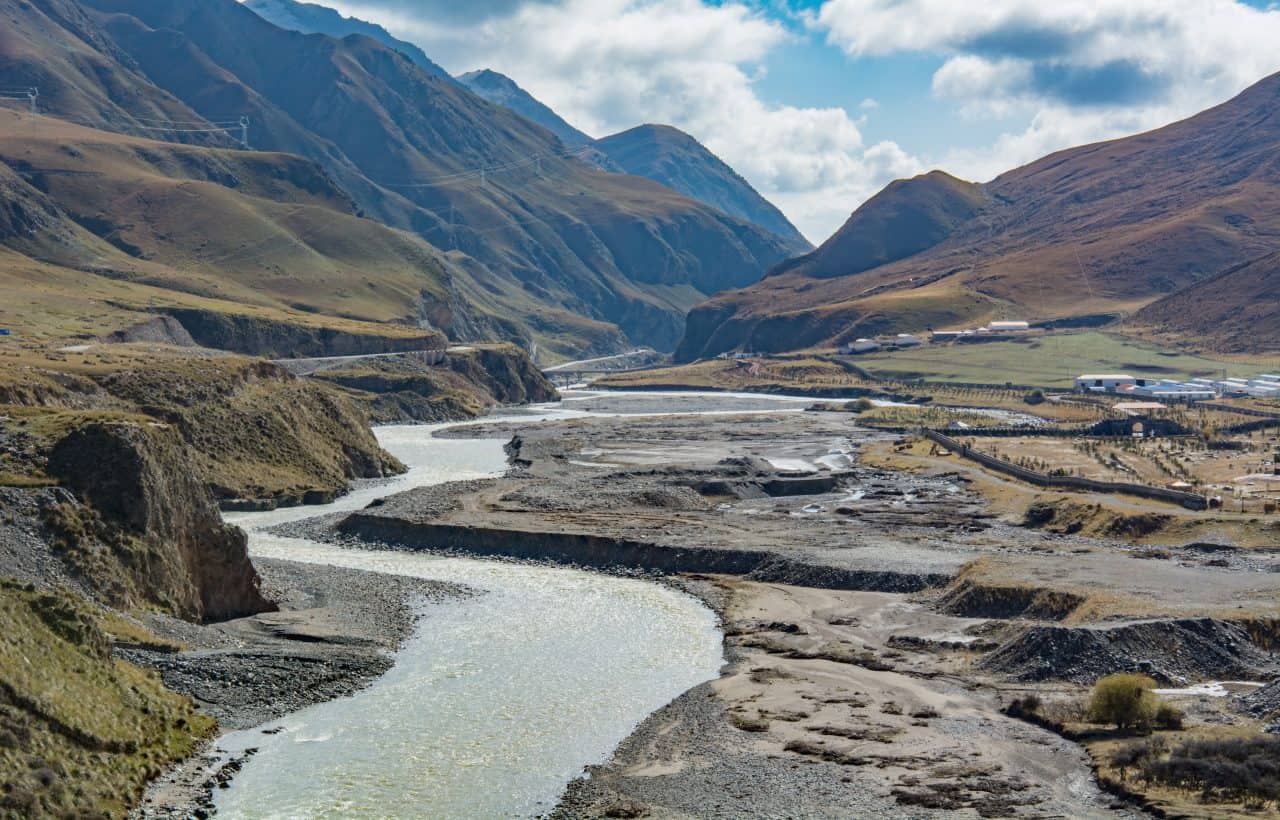
In a recent study, Kharrazi explored the resilience of the Heihe river basin in China ©smiling_z | Shutterstock
What is missing from current approaches of studying resilience?
There is a need for more empirical advancements on the concept of resilience. Furthermore, empirical approaches need to be tested with real data and improved for their ability to measure and apply in policymaking. If you look at the Sustainable Development Goals (SDGs) the concept of resilience is used numerous times, however the indicators used to reflect the concept need to be improved to better reflect the elements of the concept of resilience. This includes the ability to consider adaptation, the ability to integrate social and environmental dimensions, and the ability to evaluate systems-level trade-offs.
We need to apply the different empirical approaches to the concept of resilience towards real-world sustainability challenges. With the emergence of big data, especially urban big data, we can better apply and improve these models.
How did you personally become interested in this field of research?
I always wanted to make a positive impact for humanity and our common interest in sustainable development. When I first started my PhD, my PhD supervisor at Tokyo University, Dr. Masaru Yarime, told me to always set your sight on the ‘vast blue ocean’ and how as researchers we should dedicate our time to critically important yet less researched areas. Given the global discussions of SDGs and the Agenda 2020 at that time I became interested in the concept of resilience, its relationship to common sustainability challenges, and our inability to measure and quantify this importance concept. My research stay at IIASA and YSSP and especially my experience with the ASA group strengthened my passion to contribute to this area and therefore since my PhD I have continued to research in this area and apply it to various domains, such as energy, water, and trade.
How would you say IIASA has influenced your career?
Without IIASA and especially the YSSP in the Advanced Systems Analysis program, my academic career would have never taken off. I am truly indebted to the YSSP, where I learned how to engage in scientific research with others from diverse academic and cultural backgrounds and most importantly had the chance to publish high quality research papers. IIASA also gave me the chance to get experience in applying for international competitive funding schemes and truly believe in the importance of science diplomacy and influence of science on global governance of common human-environmental problems in our modern world.
Follow Ali Kharrazi on Twitter
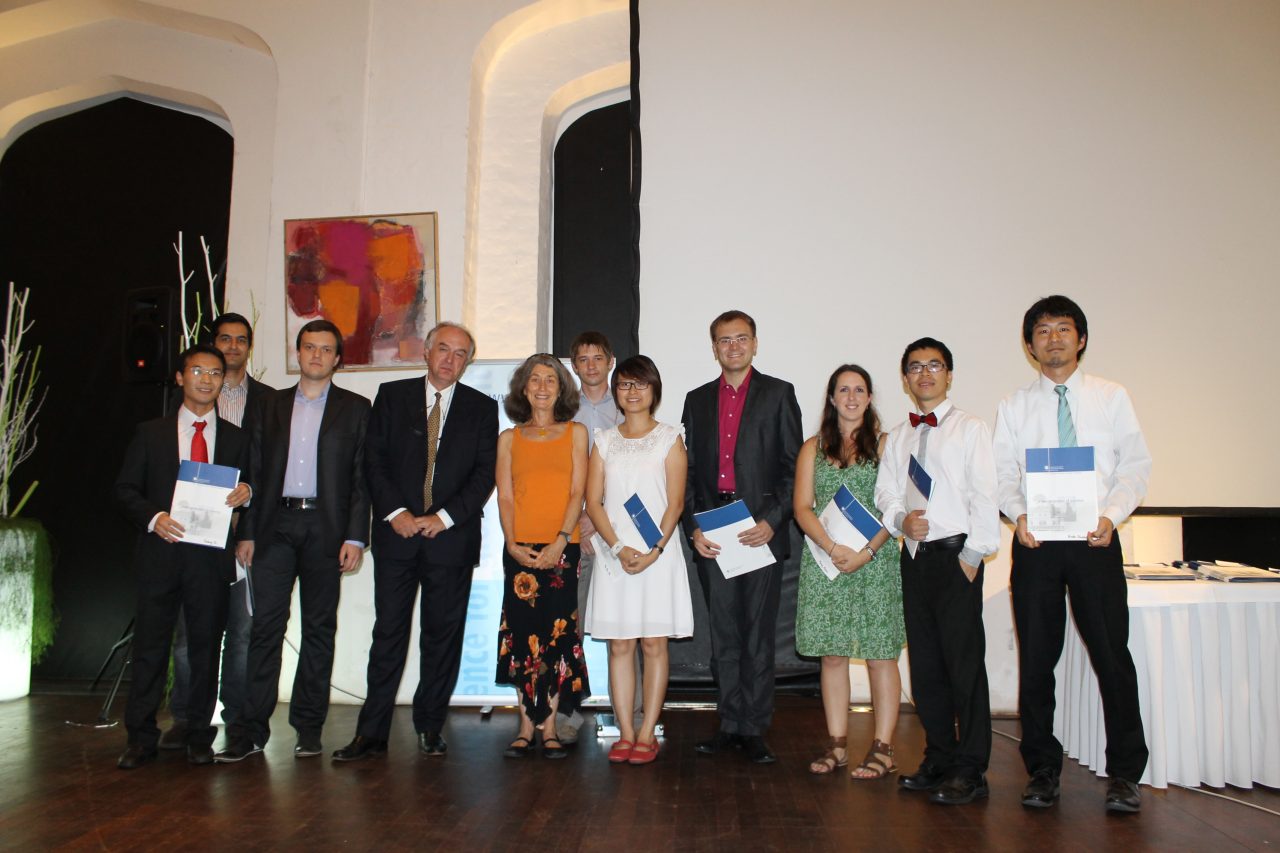
Ali Kharrazi, second from left, received his certificate with other participants of the 2012 YSSP
References
Kharrazi A, Akiyama T, Yu Y, & Li J (2016). Evaluating the evolution of the Heihe River basin using the ecological network analysis: Efficiency, resilience, and implications for water resource management policy. Science of the Total Environment 572: 688-696. http://pure.iiasa.ac.at/13594/
Kharrazi A, Fath B, & Katzmair H (2016). Advancing Empirical Approaches to the Concept of Resilience: A Critical Examination of Panarchy, Ecological Information, and Statistical Evidence. Sustainability 8 (9): e935. http://pure.iiasa.ac.at/13791/
Kharrazi A, Rovenskaya E, & Fath BD (2017). Network structure impacts global commodity trade growth and resilience. PLoS ONE 12 (2): e0171184. http://pure.iiasa.ac.at/14385/
This article gives the views of the author, and not the position of the Nexus blog, nor of the International Institute for Applied Systems Analysis.
Oct 6, 2016 | Alumni, Systems Analysis
Chibulu Luo, PhD Student in the Department of Civil Engineering at the University of Toronto, and a 2016 participant in the IIASA Young Scientists Summer Program
We cannot think about sustainable development without having a clear agenda for cities. So, for the first time, the world has agreed – under the UN’s Sustainable Development Goals (SDGs) and the New Urban Agenda – to promote more sustainable, resilient, and inclusive cities. Achieving this ambitious target is highly relevant in the context of African cities, where most future urban growth will occur. But it is also a major challenge.
Of the projected 2.4 billion people expected to be added to the global urban population between now and 2050, over half (1.3 billion) will be in Africa. The continent’s urban communities will experience dramatic shifts in living and place significant pressure on built infrastructure and supporting ecosystem services. As many cities are yet to be fully developed, newly built infrastructure (estimated to cost an additional US$30 to $100 billion per year) will impact their urban form (i.e. the configuration of buildings and open spaces) and future land use.
In order to realize the SDGs, African cities, in particular, need an ecosystem-based spatial approach to urban planning that recognizes the role of nature and communities in enabling a more resilient urban form. In this regard, more comprehensive understanding of the dynamics between urban form and the social and ecological aspects of cities is critical.
Unfortunately, research to investigate these relationships in the context of African cities has been limited. That’s why, as a Young Scientist at IIASA, I sought to address these research priorities, by asking the following questions: What is the relationship between urban form and the social and ecological aspects of African cities? How has form been changing over time and what are the exhibiting emergent properties? And what factors are hindering a transition towards a more resilient urban form?
Fundamentally, my research approach applies a social-ecological system (SES) lens to investigate these dynamics, where resilience is defined as the capacity of urban form to cope under conditions of change and uncertainty, to be able to recover from shocks and stresses, and to retain basic function. At the same time, resilience is characterized by the interplay between the physical, social, and ecological performance of cities.
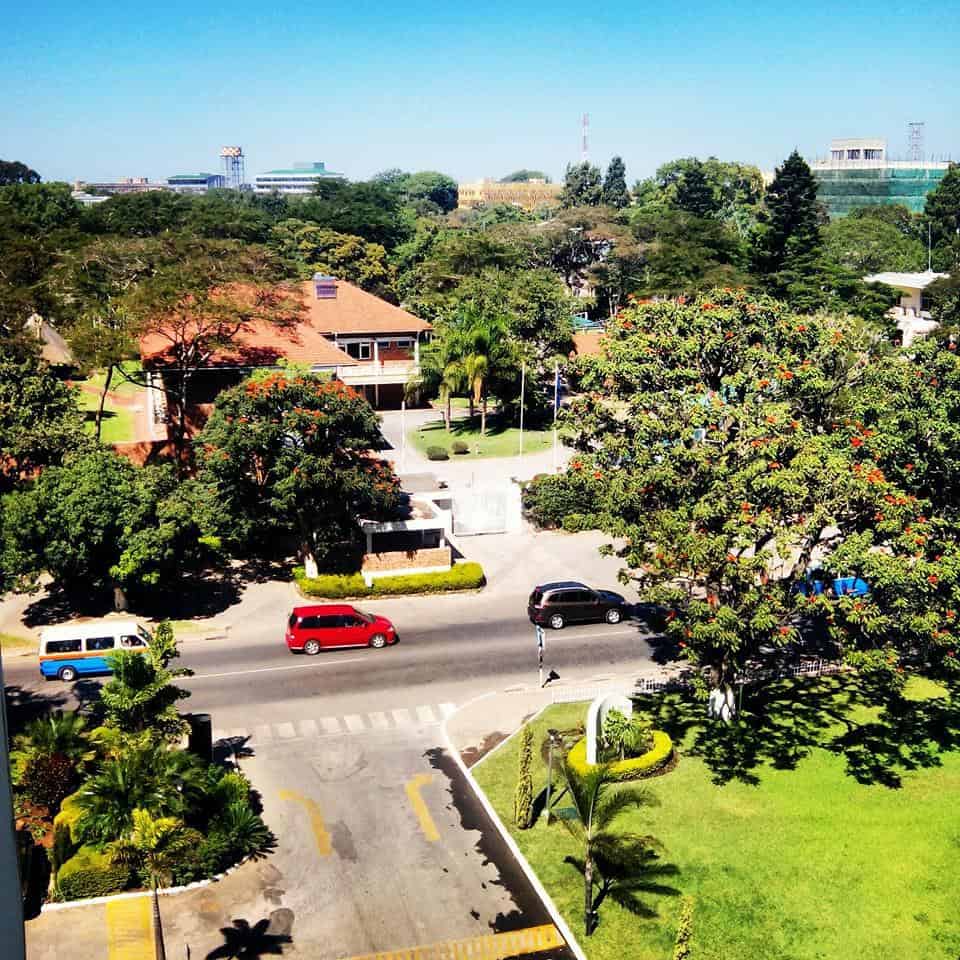
Resilient urban forms are spatially designed to support social and ecological diversity, such as preserving and managing urban greenery
Photo Credit: Image of Lusaka, Zambia, posted on #BeautifulLusaka Facebook Page
Currently, Africa’s urbanization is largely unplanned. Urban expansion has led to the destruction of natural resources and increased levels of pollution and related diseases. These challenges are further compounded by inadequate master plans – which often date back to the colonial era in many countries – and capacity to ensure equitable access to basic services, particularly for the poorest dwellers. Consequently, over 70% of people in urban areas live in informal settlements or slums.
My summer research focused on the specific case of Dar es Salaam, Tanzania, and Lusaka, Zambia – two cities with very different forms, and social and ecological settings. I used the SES approach to develop a more holistic understanding of the local dynamics in these cities and emerging patterns of growth. My findings show that urbanization has resulted in high rates of sprawl and slum growth, as well as reductions in green space and increasing built-up area. This has ultimately increased vulnerabilities to climate-related impacts such as flooding.
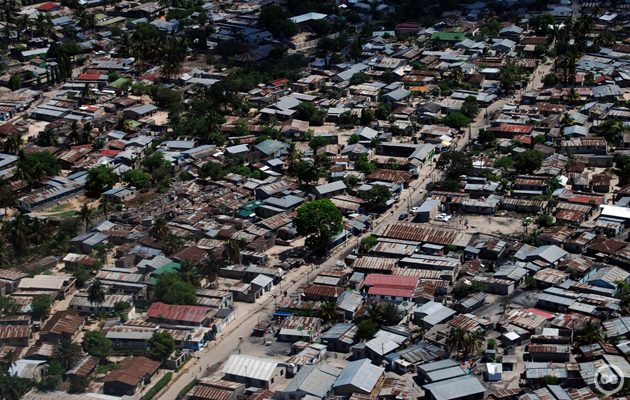
Densely built slum in Dar es Salaam due to unplanned urban development
Photo Credit: tcktcktck.org
Using satellite images in Google Earth Engine, I also mapped land cover and urban forms in both cities in 2005 and 2015 respectively, and quantitatively assessed changes during the 10-year period. Major changes such as the rapid densification of slum areas are considered to be emergent properties of the complex dynamics ascribed by the SES framework. Also, urban communities are playing a significant role in shaping the form of cities in an informal manner, and are not often engaged in the planning process.
Approaches to address these challenges have been varied. On the one hand, initiatives such as the Future Resilience for African Cities and Lands (FRACTAL) project in Lusaka are working to address urban climate vulnerabilities and risks in cities, and integrate this scientific knowledge into decision-making processes. One the other hand, international property developers and firms are offering “new visions for African cities” based on common ideas of “smart” or “eco“ cities. However, these visions are often incongruous with local contexts, and grounded on limited understanding of the underlying local dynamics shaping cities.
My research offers starting point to frame the understanding of these complex dynamics, and ultimately support more realistic approaches to urban planning and governance on the continent.
References
Cobbinah, P. B., & Darkwah, R. M. (2016). African Urbanism: the Geography of Urban Greenery. Urban Forum.
IPCC (b). (2014). Working Group II, Chapter 22: Africa. IPCC.
LSE Cities. (2013). Evolving Cities: Exploring the relations between urban form resilience and the governance of urban form. London School of Economics and Political Science.
OECD. (2016). African Economic Outlook 2016 Sustainable Cities and Structural Transformation. OECD.
The Global Urbanist. (2013, November 26). Who will plan Africa’s cities? Changing the way urban planning is taught in African universities.
UNDESA. (2015). Global Urbanization Prospects (Key Findings).
Watson, V. (2013). African urban fantasies: dreams or nightmares. Environment & Urbanization.
Note: This article gives the views of the author, and not the position of the Nexus blog, nor of the International Institute for Applied Systems Analysis.
Mar 31, 2016 | Systems Analysis
By Melina Kourantidou, MSA 2015 participant, PhD student, Department of Environmental and Business Economics, University of Southern Denmark
In summer 2015 I participated in the Summer Academy on Economic Growth and Governance of Natural Resources in Lomonosov Moscow State University. I was inspired by the interdisciplinary lectures there as well as by recent developments in Arctic marine governance to propose a game-theoretical model for Arctic fisheries management.

While commercial fishing in the central Arctic Ocean is unlikely to become common anytime soon, fisheries management in the region includes complex decision making challenges. © Fernbach Antal – Fotolia | Dollar Photo Club
In July 2015, representatives from the five Arctic Ocean coastal states (Canada, Denmark, Norway, Russia and the United States) signed the Declaration Concerning the Prevention of Unregulated High Seas Fishing in the Central Arctic Ocean. In the declaration text it is clearly stated that “commercial fishing in the high seas portion of the central Arctic Ocean is unlikely to occur in the near future.” This approach increases the stature of the Precautionary Principle, a strategy that copes with possible risks in cases where scientific information is limited. The declaration is the first official attempt to regulate international waters of the Central Arctic Basin. While commercial fishing in the central Arctic Ocean is unlikely to become common anytime soon, fisheries management in the region includes complex decision making challenges, while it is also complicated by multiple factors, including transboundary fish stocks—those crossing boundaries of Exclusive Economic Zones (EEZs) — and straddling stocks (those typically found in the high seas adjacent to the EEZ) arising from the unsettled maritime boundary lines, thus often calling for the establishment of an effective bilateral or multilateral regime.
The contentious and divisive issue of how to handle Arctic fisheries has mostly been discussed so far in literature from a biodiversity standpoint rather than an economic one. Yet looking at the problem from an economic standpoint could help provide information that could prevent optimal use of resources and thus contribute to preventing irrational behaviors that may lead to the collapse or disruption of the ecosystem. Optimization theory provides critical insights for individual fishers or countries pursuing the most profitable strategy (higher payoffs). At the same time it can also prove useful for broader decision-making processes whereby all interested parties cooperate on the management of Central Arctic fish stocks.
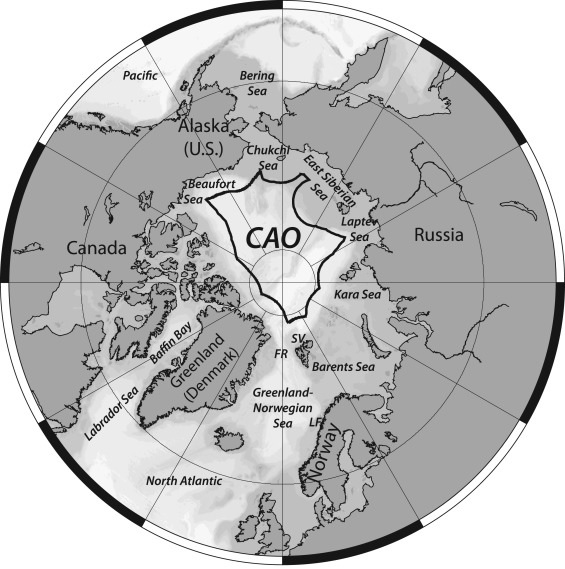
A map of the Central Arctic Ocean shows the many countries that border the ocean. © Shephard et al., 2016
Game theory can potentially contribute in a more complex setting, with two or more actors—states in our case—involved in fishing resource management and with each state being able to choose among a set of available options, with their payoff dependent on other states’ choices.
There are a number of different types of games available in the game theoretical framework. Given the existing risks and uncertainties over Arctic marine resources I would propose a differential game setting as a baseline scenario. A differential game is a mathematical formulation used for either conflict or cooperation where players’ strategies are changing over time.
A differential game seems suitable since there is an underlying assumption that the “Arctic players” involved make decisions at all time points and not necessarily in specific time intervals. Furthermore a repeated static game (players deciding simultaneously with no prior knowledge of other players’ choices), such as the Prisoner’s Dilemma, would probably not work as well here, since the payoff functions of our players would not be time-dependent.
If we are looking for a solution where all involved Arctic states agree to cooperate on the management of marine resources in the Central Arctic, we would probably need to solve it as a standard optimal control problem, through the use of maximum principle or dynamic programming. In other words the outcome of optimizing a joint welfare function should be examined regarding its efficiency, which brings together the different Arctic players in a joint effort to maximize their average individual welfare.
Another theory known as Nash equilibrium could provide useful insights with regard to incentives and motivations, especially in cases, like the one described here, where it is rather daunting to predict how different players will behave in a game. A Nash equilibrium comes down to a set of different strategies for each one of the players included in the game, indicating that neither player has incentive to change their choice (taking others’ choices as given) since their payoffs are not improving anyway.
An open-loop solution that gives Nash equilibrium would result in all players having absolutely no incentive to deviate from their specific strategic path, given the path of other players or in other words having the players at a Nash Equilibrium would make them unwilling to act differently, since they would be worse off if they did.
An Open Loop Nash Equilibrium can be examined where there is exclusive dependence on the time variable; if a player deviates from the equilibrium control, even if briefly, and decides to return to its former behavior, the equilibrium is broken. Conversely, in a feedback (or closed-loop) Nash Equilibrium which is strongly time consistent, the dependence lies on the current state of the system. Differential games can generally help towards answering whether a potential cooperative solution can be achieved through a Nash equilibrium of a non-cooperative game.
Yet another question is whether countries would prefer to cooperate instead of competing for fishing in the Central Arctic. A cooperative scenario would require a Net Present Value (sum of benefits minus sum of costs, both in present values) larger than the non-cooperative scenario, thus covering the opportunity costs arising from the cooperative case. If this condition is not satisfied we will have to accept that there will be a non-cooperative behavior up to the point that cooperation turns lucrative for all players.
Game theoretic approaches with regard to stock management have provided useful insights and directed new lines of inquiry, but the dynamically changing Arctic raises issues that call for coordinated responses, for example through the use of more robust tools such as evolutionary game theory. Given that many species are expected to expand to yet unexploited parts of Arctic waters, one major concern is the consequences of coastal states’ harvesting activities on society’s wellbeing, and the ways in which it will be made possible to leave a positive legacy for future generations.
Looking at the interplay of ecology and economic behavior is one way that scientists can begin to answer these questions. Meticulous research on strategies of defection, cooperation and enforcement can be a cornerstone for establishing and managing effective ways to protect the Arctic marine environment, taking into account the current dearth of research in existing and future biodiversity.
Read my full report on the MSA 2015 Web site (PDF)
Note: This article gives the views of the author, and not the position of the Nexus blog, nor of the International Institute for Applied Systems Analysis.
Mar 18, 2016 | Alumni, Systems Analysis, Young Scientists
By Célian Colon, PhD student at the Ecole Polytechnique in France & IIASA Mikhalevich award winner
How can we best tackle risks in our complex and interconnected economies? With globalization and information technologies, people and processes are increasingly interdependent. Great ideas and innovations can spread like wildfire. However, so can turbulence and crises. The propagation of risks is a key concern for policymakers and business leaders. Take the example of production disruption: with global supply chains, local disasters or man-made accidents can propagate from one place to another, and generate significant impact. How can this be prevented?

Risk propagation is like a domino effect. Credit: Martin Fisch (cc) via Flickr
As part of my PhD research, I met professionals on the ground and realized that supply risk propagation is a particularly tricky issue, since most parts of the chains are out of their control. Supply chains can be very long, and change with time. It is difficult to keep track of who is working with whom, and who is exposed to which hazard. How then can individual decisions mitigate systemic risks? This question directly connects to the deep nature of systemic problems: everyone is in the same boat, shaping it and interacting with each other, but no one is individually able to steer it. Surprising phenomena can emerge from such interactions, wonderfully illustrated by bird flocking and fish schooling.
As an applied mathematician thrilled by such complexities, I was enthusiastic to work on this question. I built a model where firms produce and interact through supply chain relationships. Pen and paper analyses helped me understand how a few firms could optimally react to disruptions. But to study the behavior of truly complex chains, I needed the calculation power of computers. I programmed networks involving a large number of firms, and I analyzed how localized failures spread throughout these networks, and generate aggregate losses. Given the supply strategy adopted by each firm, how could systemic risk be mitigated?
With my collaborators at IIASA, Åke Brännström, Elena Rovenskaya, and Ulf Dieckmann, we have highlighted the key role of coordination in managing risks. Each individual firm affects how risks propagate along the chain. If they all solely focus on maximizing their own profit, significant amounts of risk remain. But if they cooperate, and take into account the impact of their decisions on the risk profile of their trade partners, risk can be effectively mitigated. Reducing systemic risks can thus be seen as a common good: costs are heterogeneously borne by firms while benefits are shared. Interestingly, even in long supply chains, most systemic risks can be mitigated if firms only cooperate with only one or two partners. By facilitating coordination along critical supply chains, policy-makers can therefore contribute to the reduction of risk propagation.

Colon’s model analyzes how firms produce and interact through supply chain relationships. Credit: Jan Buchholtz (cc) via Flickr
Drawing robust conclusions from such models is a real challenge. On this matter, I benefited from the experience of my IIASA supervisors. Their scientific intuitions greatly helped me focusing on the most fertile ground. It was particularly exciting to borrow techniques from evolutionary ecology and apply them to an economic context. Conceptually, how economic agents co-adapt and influence each other shares many similarities with the co-evolution of individuals in an ecological environment. To address such complex issues, I strongly believe in the plurality of approaches: by illuminating a problem from different angles, we can hope to see it more clearly!
Note: This article gives the views of the author, and not the position of the Nexus blog, nor of the International Institute for Applied Systems Analysis.
Feb 12, 2016 | Systems Analysis
By Sergio Rinaldi, IIASA Evolution and Ecology Program and Politecnico di Milano, Italy
Is it possible to predict how love stories develop, progress, and end using mathematical models? I have studied this question over the past 20 years with a group of researchers at IIASA and at the Politecnico di Milano, and as we show in our new book Modeling Love Dynamics (World Scientific, 2016), the answer is yes. The emerging message is that prediction is possible, if we can describe in formulas the way each individual reacts to the love and to the appeal of the partner.
Consider a standard love story, which develops like those described in a classical Hollywood movie such as Titanic. This story can be easily modeled, if one considers reasonably appealing individuals who increase their reaction with the partner’s love – so called secure individuals. Starting from the state of indifference, where the individuals are at their first encounter, their feelings continuously grow and tend toward a positive plateau.

Mala Powers and José Ferrer in Cyrano de Bergerac, 1950. – Public Domain
Love stories become more intriguing when one individual is not particularly appealing, if not repelling, as in the fairy tale “Beauty and The Beast.” Indeed, in these cases, there exists also a second romantic regime, which is negative and can therefore entrain, in the long run, marital dissolution. In order to avoid that trap, people who are not very charming, or believe to be so, do all they can to look more attractive to the partner. At the first date, she wears her nicest dress and he shows up with his best fitting T-shirt. However, after a while, the bluffing can be interrupted, because the couple has entered the safe basin of attraction of the positive regime. Needless to say, the model also supports much more sophisticated behavioral strategies, like that described by Edmond Rostand in his “Cyrano de Bergerac,” the masterpiece of the French love literature.
Not all individuals are secure. Indeed, some people react less and less strongly when the love of the partner overcomes a certain threshold. These individuals, often very keen to flirtation, are incapable of becoming one with their partner. The model shows that couples composed of insecure individuals tend, with almost no exception, toward an unbalanced romantic regime in which the most insecure is only marginally involved and is therefore prone to break up the relationship at the first opportunity. This is why after just 20 minutes of the very long “Gone with the Wind,” when one realizes that Scarlett and Rhett are both insecure, the model can already predict the end of the film, where he quits her with the lapidary “Frankly, my dear, I don’t give a damn.” The same conclusion is expected if only one of the two individuals is insecure. This explains the numerous failures in the romantic life of some individuals, like the beautiful star Liz Taylor, who is described as very insecure in all her biographies, and went, indeed, through eight marriages.

Clark Gable and Vivien Leigh in Gone with the Wind, 1939 – MGM Pictures | Public Domain
Mathematical models can also be used to interpret more complex romantic behaviors. Particularly important is the case of individuals who overestimate the appeal of the partners when they are more in love with them (like parents who have a biased view of the beauty of their own kids). Interestingly, if insecurity is also present, biased couples can have romantic regimes characterized by recurrent ups and downs. In other words, the theory says that bias and insecurity is an explosive mix that triggers turbulence in the life of a couple.
In the second part of the book we focus on the effects of the social environment and to the consequences of extra-emotional compartments. In this context, our analysis of the 20-years long relationship between Laura and the famous Italian poet Francis Petrarch shows that poetic inspiration is an important destabilizing factor, responsible for transforming a quiet relationship into a turbulent one.
Finally, we studied triangular relationships, with emphasis on the effects of conflict and jealousy. In all these cases the dynamics of the feelings can be very wild, up to the point of being chaotic and, hence, unpredictable. When this occurs, the life of the couple becomes unsustainable, because painful periods of crisis can virtually start at any moment: a heavy permanent stress. The model can thus explain why the relationship is often interrupted, sometimes even tragically, as in the famous film by François Truffaut “Jules et Jim”, where Kathe’s suicide is perceived as a real relief.
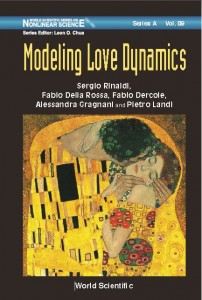 More information: Watch a video of Sergio Rinaldi’s talk at the 2015 Systems Analysis Conference.
More information: Watch a video of Sergio Rinaldi’s talk at the 2015 Systems Analysis Conference.
Reference
Rinaldi S, Della Rossa F, Dercole F, Gragnani A, Landi P, (2015). Modeling Love Dynamics. World Scientific, Singapore [January 2016] http://www.worldscientific.com/worldscibooks/10.1142/9656
Note: This article gives the views of the author, and not the position of the Nexus blog, nor of the International Institute for Applied Systems Analysis.















You must be logged in to post a comment.